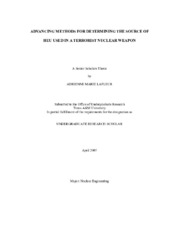| dc.description.abstract | An algorithm was developed that uses measured isotopic ratios from fission product residue following the detonation of a high-enriched uranium nuclear weapon to compute the original attributes of the material used in the device. The specific attributes assessed are the uranium isotopics (considering 234U, 235U, 236U, and 238U) and the enrichment process used to create the material (e.g., gaseous diffusion, gas centrifuge, etc.). Using the original attributes of the weapon significantly increases the probability of identifying the perpetrator of the attack. In this study, research was conducted to perform sensitivity analysis of the calculated values, analyze alternate enrichment methods, determine the source (uranium mine) from which the feed material was taken and assess potential “spoofing” techniques. The purpose of this research was to verify that the analytical method developed would remain valid for a multitude of variations that could be used to disguise the origin of the nuclear material in the device. It is envisioned that this methodology could serve as a preprocessing step to a more computationally intensive and more accurate system in the event of a nuclear terrorist attack. | en |


